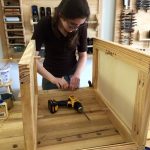We may receive a commission when you use our affiliate links. However, this does not impact our recommendations.
Basic handplane theory states that long planes are for straightening wood and short planes are for smoothing it. The planes in the middle can do either job or be set up for roughing out the work.
But all planes do some straightening of the work, and most planes do some smoothing, too. So this simple rule of thumb is actually a bit more complex in practice. After all, some very good woodworkers tend to use one plane exclusively. Paul Sellers favors his No. 4. David Charlesworth is fond of his No. 5-1/2. And the late Alan Peters did most planing tasks with his No. 7.
Here’s my attempt to explain the length of planes in as few words as possible: A handplane can easily and reliably flatten a surface that is about twice the length of its sole. Once your work is more than twice as long as your sole, a good deal more skill is involved.
So yes, you can true a 48”-long edge with a block plane. But it is child’s play to do it with a No. 8.
This rule of thumb also helps beginners choose a good first plane. If you do small-scale work, a block plane or a No. 3 might be all you ever need. But if you build furniture on the scale of Megan Fitzpatrick, your work will be easier with a longer plane.
If you are struggling to get a surface dead flat, pick up a longer plane. If you are struggling to get its surface completely planed in as few strokes as possible (flatness be danged), pick up a smaller plane.
And know that as you get better with handplanes, you’ll usually choose the sharpest one.
— Christopher Schwarz
While my book “Handplane Essentials” is no longer in print, you can still purchase a pdf of the book, which is filled with facts and observations about this iconic tool. Check it out here at ShopWoodworking.com.
Here are some supplies and tools we find essential in our everyday work around the shop. We may receive a commission from sales referred by our links; however, we have carefully selected these products for their usefulness and quality.












Just took a class from Christopher and (Deneb from Lie-Nielsen). Very enlightening. We learned many things, but the most important for me were about sharpening. Using a plane with a sharp blade made its use much easier and the result superior to my previous uses. I still would use a planer and jointer for the majority of my planing and jointing work, but I can see how there are many uses for hand planes that would lead to a better finish on the surface which might not be possible through just sanding alone. Anyway, I can’t say enough about sharpening being the key to success having been an under-achiever as a sharpener for many years. I just need more practice.
“On the scale of Megan Fitzpatrick” is what, about 5′ 5″?
As a follow up to this. How flat does a plane really need to be for jointing? I have a no 8 that is hollow in the middle, and it seems that I have to pick between hobbies now — woodworking or flattening my no 8.